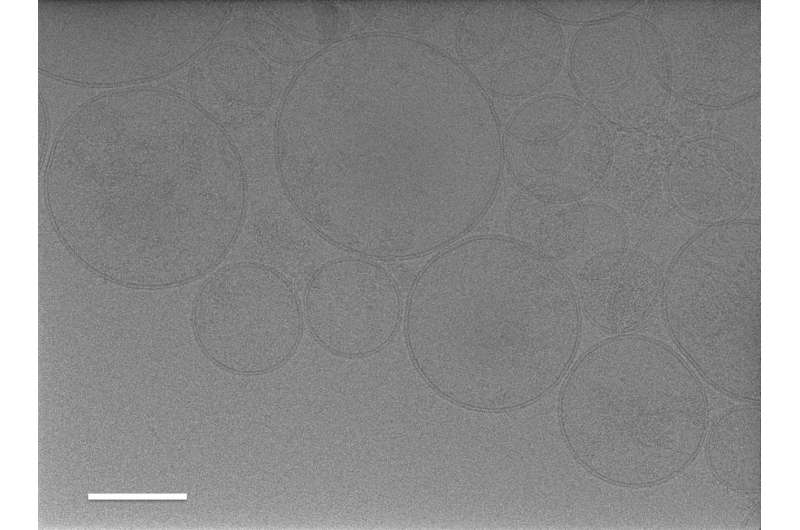Cryo-electron microscopy image showing exosomes isolated from Langat virus (LGTV)-infected Ixodes scapularis tick cells. Scale bar 100 nm. Credit: Michael Woodson, Michael B. Sherman and Hameeda Sultana
Scientists have shown for the first time that exosomes from tick cells can aid transmission of viral proteins and genetic material from arthropod to vertebrate host cells, according to new research published in PLOS Pathogens.
When ticks (Ixodes scapularis species; commonly known as deer ticks) bite humans or other vertebrates, they can transmit dangerous, brain-infecting viruses in the Flaviviridae viral family, such as tick-borne encephalitis virus (TBEV). However, the mechanisms underlying transmission of Flaviviridae from tick to vertebrate host are poorly understood.
Previous studies have shown that some other pathogens use exosomes—tiny, membrane-bound spheres released from cells—to facilitate transmission and infection. Dr. Hameeda Sultana of Old Dominion University, Virginia, and colleagues hypothesized that tick-borne Flaviviridae viruses may use similar techniques.
To investigate this hypothesis, the researchers infected cells from an Ixodes scapularis-derived cell line (ISE6) with tick-borne Langat virus (LGTV), which is closely related to TBEV but safer for laboratory work. Using cryo-electron microscopy, they showed that infected tick cells indeed produced exosomes, and further investigation showed that these contained LGTV RNA and proteins.
Additional experiments using human and vertebrate cell lines revealed more about the role of exosomes in LGTV transmission. LGTV-carrying tick exosomes were able to infect keratinocytes, cells found at the outermost layer of human skin and human blood endothelial cells. LGTV RNA and proteins were also found in exosomes produced by vertebrate cells; these exosomes were capable of transmitting LGTV materials from a cell type found at the vertebrate blood-brain barrier to neuronal cells, as well as between neuronal cells.
These findings suggest that, when an infected tick bites a vertebrate, LGTV and other tick-borne Flaviviridae viruses may use tick exosomes to drive transmission to the vertebrate host. Within the vertebrate host, exosomes may also aid dissemination and invasion of the central nervous system.
Further research and deeper understanding of these exosome-driven mechanisms could eventually aid development of new strategies to prevent transmission.
More information: Zhou W, Woodson M, Neupane B, Bai F, Sherman MB, Choi KH, et al. (2018) Exosomes serve as novel modes of tick-borne flavivirus transmission from arthropod to human cells and facilitates dissemination of viral RNA and proteins to the vertebrate neuronal cells. PLoS Pathog 14(1): e1006764. doi.org/10.1371/journal.ppat.1006764
Journal information: PLoS Pathogens
Provided by Public Library of Science





















